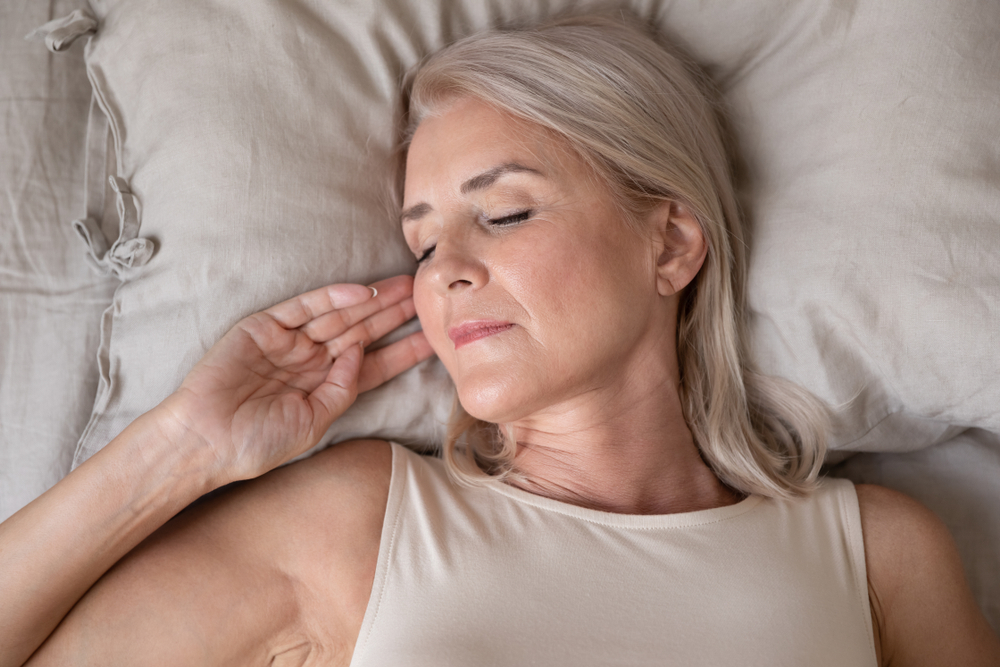
As women age, their hormone levels naturally decline, which can lead to a variety of symptoms such as hot flashes, night sweats, and mood changes. Hormone therapy has traditionally been used to alleviate these symptoms, but many women have concerns about the potential risks associated with synthetic hormone replacement. As a result, natural estrogen replacement has gained popularity as an alternative approach to hormone therapy. We will explore what natural estrogen replacement is, how it works, and its potential benefits and risks. We will also discuss various natural sources of estrogen, herbal remedies, lifestyle changes, and other factors to consider when choosing a natural estrogen replacement therapy.
What is Natural Estrogen Replacement and How Does it Work?
Natural Estrogen Replacement refers to the use of plant-based or bioidentical hormones to replace declining levels of estrogen in women who have reached menopause or who have had their ovaries surgically removed.
Estrogen is a hormone that is naturally produced by the ovaries and is responsible for regulating various functions in a woman’s body, including menstrual cycle, bone density, and vaginal lubrication. However, as women age, their bodies gradually produce less estrogen, and this can lead to a range of symptoms, including hot flashes, vaginal dryness, mood changes, and decreased bone density.
Natural estrogen replacement therapy can help alleviate these symptoms by providing the body with a source of estrogen. Plant-based sources of estrogen, such as soy and red clover, contain compounds that mimic the effects of estrogen in the body. Bioidentical hormones, on the other hand, are synthesized in a laboratory and have the same chemical structure as the estrogen produced by the human body.
It’s important to note that the use of natural estrogen replacement therapy is a complex medical decision and should only be considered under the guidance of a healthcare professional. Women considering ERT should discuss the risks and benefits with their doctor and undergo regular monitoring to ensure that their hormone levels remain balanced.
The Benefits of Natural Estrogen Replacement vs. Synthetic Hormone Therapy
There are important differences between natural estrogen replacement and synthetic hormone therapy.
- Natural estrogen replacement uses plant-based hormones called phytoestrogens.
- Synthetic hormone therapy uses man-made hormones that are chemically identical to human hormones.
The benefits of natural estrogen replacement include potentially lower risk than synthetic hormone therapy, relief from symptoms of estrogen deficiency like hot flashes, and potential additional health benefits like reduced risk of certain health problems such as osteoporosis and heart disease.
In contrast, synthetic hormone therapy has been associated with an increased risk of certain health problems like blood clots, stroke, and breast cancer, and may be less effective at reducing certain symptoms of estrogen deficiency.
Overall, the best approach for each woman will depend on her individual health history and needs. Always discuss the use of hormone therapy with a healthcare provider to determine the most appropriate approach for you.
Common Signs of Estrogen Deficiency and How Natural Replacement Can Help
As women age, their levels of estrogen naturally decline, which can lead to a range of symptoms that impact quality of life. Common signs of estrogen deficiency include:
- Hot flashes
- Night sweats
- Vaginal dryness
- Mood changes
- Sleep disturbances
- Changes in skin, hair, and nails
- Increased risk of certain health problems like osteoporosis and heart disease
Fortunately, natural estrogen replacement can help alleviate many of these symptoms and reduce the risk of certain health problems. Natural estrogen replacement uses plant-based hormones called phytoestrogens that are similar in structure to human estrogen, allowing them to bind to estrogen receptors in the body and provide relief from symptoms of estrogen deficiency.
It’s important to note that natural estrogen replacement may not be appropriate for everyone and should always be used under the guidance of a healthcare provider. Nonetheless, for women experiencing signs of estrogen deficiency, natural estrogen replacement may be a promising approach to improve quality of life and reduce the risk of certain health problems.
Top Natural Sources of Estrogen for Hormone Balance
There are many natural sources of estrogen that can help promote hormone balance and alleviate symptoms of estrogen deficiency. These include:
Soy products: Soybeans and products made from soy, like tofu and soy milk, contain high levels of phytoestrogens, which are plant-based compounds that mimic the effects of estrogen in the body.
Flaxseed: Flaxseed is another great source of phytoestrogens, as well as omega-3 fatty acids and fiber, which can promote overall health and hormone balance.
Red clover: Red clover is a flowering plant that contains high levels of phytoestrogens, and has been used for centuries to alleviate symptoms of menopause.
Chickpeas: Chickpeas, also known as garbanzo beans, contain phytoestrogens as well as fiber and protein, making them a healthy and filling addition to any diet.
Black cohosh: Black cohosh is a plant native to North America that has been used for centuries to treat menopausal symptoms like hot flashes and mood changes.
Incorporating these natural sources of estrogen into your diet may help promote hormone balance and alleviate symptoms of estrogen deficiency. However, it’s important to discuss any changes to your diet or supplementation with a healthcare provider, especially if you are taking medications or have a history of health conditions.
Herbal Remedies for Natural Estrogen Replacement
In addition to natural sources of estrogen in food, there are also herbal remedies that can be used to promote natural estrogen replacement. Here are a few examples:
Dong quai: Dong quai is a traditional Chinese herb that has been used for centuries to treat a variety of ailments, including menopausal symptoms like hot flashes and vaginal dryness. It contains compounds that mimic the effects of estrogen in the body.
Black cohosh: As mentioned earlier, black cohosh is a plant that is native to North America and has been used for centuries to treat menopausal symptoms.
Evening primrose oil: Evening primrose oil is derived from the seeds of the evening primrose plant and contains gamma-linolenic acid (GLA), which can help regulate hormone levels.
Ginseng: Ginseng is an adaptogenic herb that has been shown to help alleviate menopausal symptoms like hot flashes and mood changes.
Chasteberry: Chasteberry, also known as vitex, is a plant that has been used for centuries to help regulate hormone levels in women.
It’s important to note that while herbal remedies can be beneficial, they should be used with caution and under the guidance of a healthcare provider. Some herbs can interact with medications or have adverse effects in certain individuals. It’s also important to use standardized extracts to ensure quality and consistency of the product.
Lifestyle Changes That Can Support Natural Estrogen Production
In addition to natural sources of estrogen and herbal remedies, certain lifestyle changes can help support natural estrogen production in the body. Here are a few examples:
Regular exercise: Regular physical activity, such as cardio or strength training, can help regulate hormone levels and increase estrogen production.
Stress reduction: Chronic stress can disrupt hormone balance, so practicing stress reduction techniques like meditation or yoga can be beneficial.
A healthy diet: A balanced diet that includes whole foods and plenty of fruits and vegetables can provide important nutrients for hormone production.
Avoiding certain chemicals: Exposure to certain chemicals in the environment, like bisphenol A (BPA) and phthalates, can disrupt hormone levels. Avoiding products that contain these chemicals, such as plastic containers and certain personal care products, can be helpful.
Getting enough sleep: Adequate sleep is important for hormone regulation and can help support natural estrogen production.
It’s important to note that these lifestyle changes are not a replacement for medical treatment, but can be used in conjunction with other treatments to promote natural estrogen production and hormone balance.
How to Choose the Right Natural Estrogen Replacement Therapy for You
First, consider the severity and frequency of your symptoms. Are you experiencing mild symptoms or more severe ones? This can help determine the strength and type of natural remedy that may be best for you.
Next, think about your personal preferences and lifestyle. Do you prefer taking supplements or incorporating certain foods into your diet? Do you have any allergies or sensitivities to specific ingredients? This can help narrow down the options and find a natural estrogen replacement therapy that fits your needs.
It’s also important to consider any existing medical conditions or medications you are taking. Natural remedies can interact with certain medications or medical conditions, so it’s important to discuss these factors with a healthcare provider before starting any new treatments.
Finally, do your research and read reviews from others who have tried natural estrogen replacement therapy. This can provide valuable insight and help you make an informed decision.
Overall, by considering these factors and working closely with a healthcare provider, you can choose the right natural estrogen replacement therapy to help manage your symptoms and improve your quality of life.
Potential Risks and Side Effects of Natural Estrogen Replacement
Interference with other medications: Certain herbal remedies, like St. John’s wort and black cohosh, can interfere with other medications, so it’s important to discuss any new supplements with a healthcare provider.
Allergic reactions: Some women may experience allergic reactions to herbal remedies, so it’s important to monitor for symptoms like rash or swelling.
Hormonal imbalances: Using herbal remedies or natural sources of estrogen without guidance from a healthcare provider can lead to hormonal imbalances.
Increased risk of certain cancers: While the research is still unclear, some studies have suggested that high levels of estrogen may increase the risk of certain cancers, like breast cancer.
Other side effects: Some women may experience side effects like nausea, headaches, or changes in menstrual bleeding patterns when using natural estrogen replacement.
It’s important to speak with a healthcare provider before starting any new treatment for estrogen deficiency to discuss the potential risks and benefits, and to determine the best course of action based on individual health history and needs.
Combining Natural Estrogen Replacement with Other Hormone Therapies
If natural estrogen replacement alone isn’t enough to address symptoms of estrogen deficiency, combining it with other hormone therapies may help. This approach can effectively balance hormones and alleviate symptoms like hot flashes, mood swings, and vaginal dryness.
However, combining natural remedies with synthetic hormone therapy comes with risks. It’s important to work closely with a healthcare provider to find the right combination of therapies and monitor for side effects.
Possible combinations include using natural remedies like black cohosh or soy isoflavones alongside low-dose estrogen therapy or combining natural progesterone cream with synthetic estrogen therapy.
Each woman’s situation is unique, so it’s important to discuss concerns or questions with a healthcare provider.
Consulting with a Healthcare Provider for Natural Estrogen Replacement Options

When exploring natural estrogen replacement options, it’s important to work with a healthcare provider who can recommend safe and effective treatments tailored to your individual needs. They may suggest lifestyle changes, herbal supplements, or hormone testing to assess your hormonal balance.
Regular consultation with a healthcare provider is crucial for monitoring potential side effects and adjusting treatment plans as needed. By working together, you can find the best natural remedies to address your symptoms and improve your overall health and wellbeing.
Don’t hesitate to schedule a consultation with a healthcare provider to explore natural estrogen replacement options and take control of your hormonal health.







